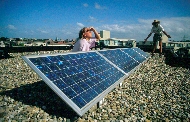

 |
 |
||||||
|
verpletterender... |
meten=weten |
index | |||||
|
|
|
||||||||||||||||||||||||||||||||||||||||||||||||||||||||||||||||||||||||||||||||||||||||||||||||||||||||||||||||||||||||||||||||||||||||||||||||||||||||||||||||
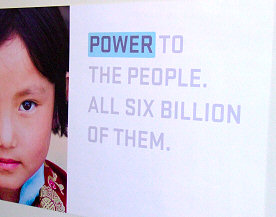 |
^^^ American thin film specialist Applied Materials had some very catchy solar energy advertisement texts on their Intersolar 2008 stand. There is more truth and justice in these few words than most of those six billion people or the politicians that boast to "represent" them realize... |
Intersolar
2008- 's werelds belangrijkste zonne-energie beurs. Het topje
van de ijsberg
Intersolar 2008 - worlds' most important solar energy fair. Only a tip of the iceberg. |
|
| <<< Entrance of Automatica fair alongside Intersolar (close cooperation due to shared common interests). With robots also used in automated PV-business showing off in a spectacular "European Soccer Dance". The European Cup matches 2008 were running during the trade fair in Switzerland and Austria, hence the welcome surprise... | |
Lesson
in PV-history: Very interesting "mobile PV museum" in the stand
of long-time German PV- and solar thermal component and system
provider, Sunset Energietechnik GmbH (website).
Fascinating insight in development in photovoltaic module technology
showing the "oldtimer" of the most rapidly developing industry
on Earth.
>>> |
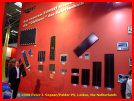 |
| <<< One of the old beauties in the Sunset Solar "museum": a SM 144 "Siemens-Interatom" module of around 1984 with 144 (9x16) perfect round, apparently monocrystalline (non-edged) cells with intricate and probably expensive front contact pattern. | |
Basics
at the stand of Germany-based Sunways.
Two so-called "ingots" from which the "wafers" (the basic template
from which all crystalline
silicium
solar
cells are made) are cut with the help of wire saws. Many
vertically integrating companies had similar set-ups to show the
various intermediate "products"
of the rapidly growing solar industry. Which still is dominated
by 90% silicium-based cell production. >>> |
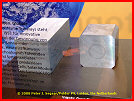 |
| <<< Monocrystalline solar cells are cut from round ingots (picture: right side is "up") that are "pulled" from a hot silicium melt. To minimise space loss in the module, edges are trimmed from the ingot (hence the typical square cells with "rounded corners"). Chinese firm Xi'an Longi Silicon Tech. Ltd is a specialist making very pure, valuable mono Si ingots by applying strong magnetic fields during the "pulling" process. | |
The
huge production of todays' solar industry demands for ever increasing
turn-through times of the delicate solar cells - that are also becoming
thinner (less than 200 µm). Hence, cell-handling machinery becomes
increasingly sophisticated. This is one of several four-armed ultrafast
robots shown on Intersolar, capable of handling solar cells
in a blink of an eye. Robot of Adept in
the stand of automation company SLS
Solar Line Saxony GmbH. >>> |
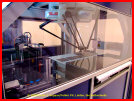 |
| <<< A very different approach of solar cell production is carried out by Evergreen Solar Inc., which has developed a unique "ribbon-string" process in which a silicium melt is pulled like a soap bubble thin film in between two wires (the composition of which is top secret) through relatively small "ovens" (reddish boxes in the image). Evergreen claims dramatic reduction in process energy and loss of silicium (almost negligable), because the rectangular wafers produced do not need to be cut from an ingot, only separated from each other. This is a huge advantage, and a serious source of cost reduction for the whole cell making process. Shown is a new production line, enabling simultaneous production of 4 "ribbons" of thin wafers. | |
Since
Evergreen is capable of doing away with the big silicium
melt ovens that are easily contaminated, they can also produce
Si cells with narrow nominal power (Wp) tolerance. They deliver
only "plus" tolerance, hence the Wp power of their
modules is always the minimum the customer will get.
Note the typical rectangular
cell-type which is the result from the "ribbon" technology. Although there have been some technological problems
(irregular
surface, polarisation effects), these apparently are overcome.
>>> |
 |
| <<< Yet another approach of Si-based module technology is carried out by the Canadian company Day4 Energy Inc. that uses a special contacting and wiring technology with, a.o., a fine square grid "mesh" on the front of the cells. This, according to the producer, results in more (nominal) power per m². The 48 cells containing modules are available in nominal powers of 160-190 Wp. A detail of the fine interconnecting electrical wiring between the multicrystalline 6 inch cells can be viewed HERE. Note the interconnections and the sign of the cell producer: "Q" stands for? (you may only guess once...). | |
 |
|
| <<< Californian (Irvine) innovator Lumeta, Inc., showed a very interesting "flat industrial roof" solution with their big monocrystalline PowerPly system using huge, 380 Wp (!) cell plates (plate size 2.4 x 1.2 m., 160 cells each, 31.75 kg.) that are glued to the flat surface of industrial roofs, and that are accompanied by modular DC cabling in protective encasing also glued to the roof. Expensive support structures are not needed, installation time is minimized. | |
PV
comet Sunpower from
the U.S.A. is rapidly developing solutions meant to facilitate
acceptance of
PV for end-consumers. Here their so-called "T10 Rooftile" system
for large industrial flat roofs (tilt app. 13 degrees) that can be
easily interlocked with other modules, and that does not need penetration
of the roof
itself in normal locations. Of course the "tile" contains a beautiful
72-cell high power module of own making using the all back contact
A-300
cells. >>> |
 |
| <<< Well-known Japanese Kyocera is upgrading the nominal power for most of their modules. This new multicrystalline specimen, KD210GH-2P, with black cells with 3 distinct "bus bars" already has a rated power of 210 Wp. Nice modules, reliable and long-time producer. Kyocera still has the world record for multicrystalline cell efficiency, 18.5%. An example can be seen HERE. | |
Spanish
producer Vidursolar
S.L. is probably "on the safe side" for their
domestic market if the feed-in regimes for free-field installations
will probably become much lower, and the Spanish market will shift
to building (integrated) PV-systems. Vidursolar makes nice
BIPV "see-through" modules, comparable to the products
of Austrian manufacturer Ertex. >>> |
 |
| <<< Possibly the biggest tiger of 'em all, Chinese Suntech Power Co., Ltd., came up with a series of appealing black modules and other products that are specifically meant to reach out to the consumer market and to narrow the gap between the hard core cell producers and the end customers of the silicium-based industry. They also showed an integrated "in-roof" system, based on the MSK Just Roof concept and an integrated "up-roof" system called Quicksnap originally from Akeena Solar. | |
"Just
for aesthetic purposes", said the representative at the
stand of Belgium solar cell producer Photovoltech about
the attractive wavy electrical wiring on these new cells. Photovoltech
also makes a new type of back-contact cells (Maxis BC+) and nowadays
is out of the module business, fully concentrating on cell production.
Customers can't wait, as with all the other cell producers on our
planet... >>> |
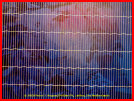 |
But... ... there is more under the sun than silicium-based photovoltaics, of course ...
|
|
<<< Possibly "the most wanted of all", at least by big project planners. A model of one of FirstSolar's CdTe thin film modules that has been sold in vast numbers to big projects in Germany and Spain. FirstSolar has already reached 10.5% module efficiency on a commercial basis, shares have skyrocketed, and they have become the biggest player in the thin-film business. Perspectives are good, but there are "prices to pay". The module price has gone up because of everlasting, huge demand, and certain third parties are involved in "fake deals" naming (but not delivering...) these popular modules (Photon, July 2008). |
|
Thin
film modules are not only attractive for big field systems
(to reduce costs and maximize profit from robust feed-in conditions).
They can also be found in the "wanted" port-folio of architects
and other parties involved in Building Integrated PV projects. Here
a photo of a girl combined with a "see-through" thin-film module
by the Taiwanese company NexPower
Technology Corp. The photovoltaic
element consists
of minute rectangular "microcells" spaced evenly to allow (day)light
passing through. >>> |
 |
More on thin film Within the strongly growing thin film sector (many start-ups carefully entering the commercial arena with a mind-gobbling spectrum of different techniques and concepts), competition has become stiff between the two big "package dealers". First, Swiss specialist Oerlikon Solar (remarkable absentee on this famous fair...) that has become known for its highly automated process for the mass production of thin film modules, and the promise of CEO Jeannine Sargent to be capable to generate solar electricity on a grid parity basis with thin film modules made on their equipment as soon as 2010 (production cost predicted to be less than € 1/Wp; Photon 5/2008: pp. 82-83). And (2) the American company Applied Materials. While Oerlikon has a fully integrated and highly automated machine package for the production of "conventional" format thin film modules in the order of 1.1 x 1.4 m. (thereby reckoning with the strict labour regulations in Europe: a person may not be allowed to carry or handle big, heavy modules in hazardous roof environments), AM is designing its module equipment machinery to be able to produce "monster modules", in particular for application in free-field installations and in BIPV applications to appeal to architects. Several of the latter could be seen on Intersolar 2008 for the first time. Applied Materials is putting its bet (or: one of its bets) on maximum system and project efficiency by producing as much PV-surface as physically possible in one single module, and then, for example, putting these type of big modules in free-field environments making use of automated glass panel handling machinery on trucks. They showed a video with a "record breaking" Wp/m² installing demonstration. Not all the visitors were convinced that having to deal with monsters like the ones shown below (both made on Applied Materials machinery) was such a good idea, in particular with respect to weight and size of the module (double glass laminate!), and its sensitivity to even mild wind gusts during the installation process. Practice will learn who has the best "bet". Or, viewing the huge demand for any type of good PV module, it will turn out that both big companies will have full order books for their machinery for years to come...
|
|
| <<< Stand of Applied Materials with a monster amorphous thin film module (9% efficiency) made by Signet Solar (using AM equipment) measuring 2.2 x 2.6 = 5.72 m² in surface. One quarter or half this size can also be made. AM claims that 7.5 times less modules are needed for 1 MWp of installed power in free field installations as with conventional thin film modules (think of the popular CdTe types of FirstSolar). These type of installations could become cheaper because of the principle "less labor per Watt", as the company claims. AM has also developed specific "plug and play" junction boxes with an unnamed third party for these kind of modules. Click here for photo. | |
Also
the company Moser
Baer Photo Voltaic Ltd. from New Delhi in what
used to be a "developing" or "third world" nation,
India, and known from the CD production industry, showed off their
alternative. And
boasted
it
is the world's
largest thin film module. It is, however, the same size as the one
from Signet Solar. Of course. It was made on ... their new AM equipment... >>> |
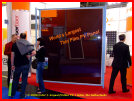 |
| <<< Big modules like the ones mentioned above, pose their own specific problems. For example, preparing and checking the huge glass laminates for production, requires special (and expensive) large equipment capable of handling the huge module sizes. Here a "GPS Perfectscan" from the Austria-based company Lisec Maschinenbau GmbH, that scans big glass laminates for faults and imperfections. | |
Another
"innovation" is the X120
thin
film module made by Inventux
Technologies AG from Berlin. Two basic differences with
the monster modules shown above (apart from size, which is
a "mere" 1.1 x 1.3 = 1.42
m²): (1) they are made up from micromorphous
Si [µSi], (2) the modules are produced on equipment from
... Oerlikon Solar. These thin film beauties will be produced
commercially
as from the
end of
2008. Rated (stabilised) power is 120 Wp. May many thin film
companies follow suit...>>> |
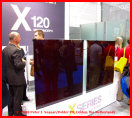 |
| <<< Although some people would refer to flexible solar modules as a "market niche", United Solar Ovonic (short: "UniSolar") has established their speciality for years, sold by a number of companies in various forms, fixed directly to flat industrial hall roofs, or to slanting or even curved zinc roofs on private houses. UniSolar is planning to produce 300 MWp of their triple junction flexible thin-film modules in 2010. A lot of industrial roofs are waiting to be covered... | |
Visitors
having the wrong opinion that there is an invisible borderline between
the "silicium boys" and the "thin-film people" should rethink whilst
visiting the stand of Number One producer of 2007, Silicium King
Q-Cells. This extremely succesful German company is not sitting
on its succes and has developed several "non-Si" off-spring
projects.
Such as its CdTe/CdS daughter Calyxo,
that is on the verge of
commercial
production with modules in a range of 35-65 Wp (IEC certificates
pending). FirstSolar: beware! >>> |
 |
| <<< The essence is in the details. Also concerning thin-film technology. One of its specific problems is a reliable fixation of the often thin double-glass laminates onto a bearing frame. Huge problems have occurred by using oversized, non-fitting clamps (leading to breakage). Hence, special clamps have been developed. For detail from the side, click here. Photo from SolarLinea II mounting system for thin-film modules by solar park developer Conergy AG from Hamburg, Germany (via their Epuron offspring). | |
Yet
another developer of thin film technology, Odersun
AG from East Germany makes flexible thin films through
a production process - a combination of CIS (Copper-Indium-diSulfide)
semiconductor (only 1 µm thin) on a supporting copper
band (1 mm thick) that can be further processed for the production
of flexible applications like the one shown at right, or even
glass laminate PV-modules (size flexible upon demand), click
here for an example of such a module. >>> |
 |
| <<< Big plans abound in the "solar scene". One of the most impressive is the combined 1 GWp thin film and LCD screen production plant (former) PV champion Sharp (German, click here for Dutch site) from Japan is planning to build in Sakai City. Here a model picture of the facility with a price tag of USD 3.3 billion. This is only one of several GWp projects announced or started up by other big PV companies. Each facility producing a nominal power of a mid-size nuclear plant in PV modules in a few years time. Year after year... | |
"Der Qual der Wahl" (not being able to see the forest through the trees): inverters The inverter market has grown rapidly along with the PV module industry and is on the forefront of technological innovation. The choice for a good inverter has become a difficult task. Off course, with the popular ever bigger growing solar parks, huge inverters of many 100 kilowatts are on the rise.
|
|
Lots
of inverters to choose from nowadays. Here is an assortment
from Wieland
Electric GmbH from Bamberg (FRG). Visible here are consumer-size
inverters (several kilowatts) from, a.o., Mastervolt, Conergy,
Delta, SMA, Diehl AKO, Solutronic, Motech and Pesos. >>> |
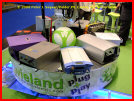 |
| <<< Characteristic series of Aurora inverters from the American (Wisconsin) Magnetek company (under the Alternative-Energies.com label) for smaller PV-systems. This lot ranging from 3.0 - 3.6 - 4.2 - 6.0 kilowatt AC, hence more or less the "lesser range" for the major German private market. There are many other brands for decentralized power generation with many more power ranges, up to several hundred kilowatts. | |
Beautiful
Diehl AKO Platinum inverter provided by sales company Matrix
Power Systems GmbH with a maximum of 4.6 kWp of DC power
and max. 4.2 kilowatt of AC power. Extensive datalogging possible
("communication stick" with USB plug, Viewmaster,
Webmaster), display showing actual AC power (graph) and other
data such as money earned (feed-in), CO2 reduced, etc. 5 year
standard guarantuee can be extended to 20 years. One of the
innovations: The production process is free from the use of
the environmentally problematic metal lead (Pb-free). >>> |
 |
| <<< Started in the Netherlands, this EVO (originally PSI) series of scalable small inverters plus control unit (right) and wireless monitoring unit (top) could have been the beginning of one hell of a solar adventure for famous Dutch electronics manufacturer Philips. Regrettably things turned out to go in a very different direction. After some problems with a weak component (all replaced in Dutch households), and the collapse of the PV market in the Netherlands, Philips sold the inventory to Steca Elektronik GmbH in Germany, who still has this 300/500 Watt concept in its portfolio. | |
The
final chapter in Philips' solar adventure was a nice 2
kilowatt (AC) inverter that has now been upgraded to
this StecaGrid 2000+ master/slave system with extensive monitoring
facilities. A big shame that this beautiful invention has
been brutally skipped from Dutch electrical engineering history
and that the original developers have not seen their hard
work and succes being put to good use on their home market!
For now the German market may profit from this beautiful
inverter. "We" wish Steca a lot of succes with
it. >>> |
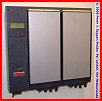 |
| <<< Always nice to see the inside of a good inverter (here one from the Sunny Mini Central series) from market leader SMA, who is rapidly expanding its already monumentous capacity to a possibly staggering 4 Gigawatt nominal power at the end of 2008. The highly successful company will enter the stock market to be able to finance their expansion plans. Top quality made in Germany. Highly facilitated by one of the most robust and intelligent feed-in regimes politicians have ever constructed, based on the world-famous EEG law. | |
Big
solar parks generate demand for huge inverter solutions. This
one, AMC 2500C ("Messe première") from Padcon
GmbH, with two powerblocks generating a total capacity
of a respectable 2.5 Megawatts, is able to feed in directly
into the medium voltage distribution network. A very interesting
tool for independent companies to eat away the fundaments from
the mostly very unhealthy oligopolies in the national electricity
markets. Note the supporting advertisement from American thin
film producer FirstSolar. In recent times, numerous BIG new
solar parks have been built with many tens of thousands of
their highly attractive CdTe modules... >>> |
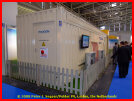 |
Concentrating solar light While in Freiburg (2007) one of the central themes appeared to be the omnipresence of a staggering array of solar "trackers" (mostly for Si-based PV-modules, and for the biggest part meant to be installed in feed-in attactive, sunny Spain), a considerable number of companies on Intersolar's first presentation in Munich were displaying an array of very interesting "solar concentrators". Not to be mistaken for the also rapidly developing concentrating solar power (CSP) technology, which applies heated fluids and steam for generating electricity in desert-like areas (these are almost always developed at a huge scale to suppress cost price of the output). The concentrators meant here all make use of various kinds of photovoltaic cells on which sunlight is concentrated via mirrors (low concentrating systems, factor in the order of up till 10 "suns") or fresnel lenses or other highly sophisticated lens/optics techniques. With fresnel lenses already almost 400 "suns" amplification has been realized by ISE spin-off Concentrix in practice, but developers are already busy with systems using concentration factors of more than a thousand "suns"... Some sources refer to this approach as CPV (concentrator photovoltaic) systems. Various concepts were shown, all with high potency for delivering as much energy as possible from relative small areas. Because of the concentration factor most of these modules have to be tracked, either on single-axis trackers (lower concentration factor), or on double-axis trackers (high concentration factor). At he bottom-line of this market segment, simple, non-tracked systems are to be found using only static mirrors. Below a few examples of this booming market. An interesting article about this market segment could already be found in the international magazine Sun & Wind Energy 3/2007: pp. 148-155. Somewhat earlier, German top magazine Photon published two articles in issue 4/2006: pp. 51-53.
|
|
| <<< New Si-Con™ 120X CPV module from the British company Silicon CPV plc using 2x2 cm. silicium cells with an efficiency of 18% and a sun concentration factor of 120x on a bidirectional tracker. The company is a spin-off of the Akhter group founded by Prof. Humayun Mughal and claims to reach grid parity in 2010 by their "disruptive" technology, making use of patented prismatic lenses. Shown here is the 48 cell MCPV-48 module with a nominal power of 150 W (measured at 850 W/m² and 60 ºC). Natural ventilation through slits in the broad side of the module. Details: prismatic cell and backside of module. | |
Another
highly interesting approach by the same company is this fascinating
module at even lower concentration factor, the Si-Con™ 4X
module. It has almost the same specifications as the higher concentrating
module shown above and is specifically designed
for rural electrification according to the datasheet for either fixed,
or low-accuracy tracking purposes. Due to simplicity of the module
approach, Silicon CPV claims to outcompete
others by
making cheaper modules. For detail, click
here. >>> |
 |
| <<< German company Solar*Tec AG, based in Aschheim, and involved in all three major fields of PV (silicium, thin-film and concentrator technology) showed their high concentrating "3rd generation" 60 W Sol*Con™ module using 144 triple junction cells (cell surface each only 4 mm²) per module and tempered front glass plates with fresnel lenses only 3,2 mm thick. | |
A
spectacular PV concentrator could be seen at the stand of SolFocus,
Inc. from Mountain View in California (U.S.A.). It makes use
of ø 31 cm. metallic parabolic primary mirrors reflecting the sun
onto a small central second (concave) mirror (glued to the glass
plate) that concentrates the sunlight
on a
glass rod that focusses the light onto a 1 mm² III-V type Spectrolab
solar cell (37% eff.) in the centre of the big mirrors. In this module
16 of these
units
are present in one casing. For detail, click
here. SolFocus is trying to translate this interesting
"Cassegrain telescope" concept (original from Ben Gurion Univ. in
Israel) into cheaper full-glass flat plates only 12 mm. thick... >>> |
 |
| <<< And yet another, low concentration approach can be seen in this peculiar configuration named Traxle™ from Poulek Solar Ltd. (tracker website: www.solar-trackers.com) making use of single axis trackers, conventional multicrystalline PV modules, and "simple" metallic mirrors (various make-up possible) in between to get more sunlight onto the solar cells. Poulek mentions this specific type a "Tracking ridge concentrator", see their specific concentrator website. | |
PVT becoming succesful? The combination of photovoltaic cell technology and simultaneous warm water production via solar thermal principles has been a major technological challenge because of the very different phyisical demands each technology has on the module buildup. There were however some companies who seem to have progressed in this field. If commercially exploitable, this promises to be an interesting combination for people and institutes not having lots of roof space, but neverthelesse wanting to profit from the sun for the production of solar electricity and hot tap water as well. A good article on the new developments with PVT appeared in German magazine Photon 6/2008: pp. 68-75.
|
|
PVT
modules ("Phototermie") from first time Intersolar guest Solarhybrid
AG from Brilon in Germany. Each "half module" has 42
monocrystalline cells fixed directly under the glass plate,
and somewhat deeper in the modules one can see the characteristic
solar
absorber
comparable to the ones found in many "conventional" thermal collectors.
Maximum solar cell temperature measured: 60,9 º C. The company also
had another novelty, a "Thermogenerator" converting surplus heat
into
electrical
energy. >>> |
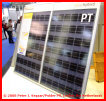 |
| <<< Different solution by IDS AG from Zürich (Switzerland): DuoSolar®, a "conventional" 175 Wp monocrystalline PV-module with on the back a "cooling plate" (max. 600 Watt thermal energy) through which heat is drawn away with a liquid system feeding a thermal solar system or heat pump. By varying the water flux, one can optimise the PV-efficiency or the solar thermal efficiency. Click here for a photo from the backside of this interesting PVT module. | |
The outer space Like
in Freiburg, there was a permanent show in open air with a number
of stands. This is the area mostly occupied by the Big Guys,
who install incredible numbers of PV modules in large free field
installations (2007-2008 was one big PV building frenzy in Spain,
before the old Decreto Real will end in September). Big
trackers keep the hormones of the often male visitor running
a little
bit faster.
We remain
children and "toys for the boys", n'est
ce pas?
|
|
Despite
their incredible downfall as a PV company (shares have seriously
fallen in price, managers are restructuring the company),
Conergy AG in
Germany has a very succesfull solar park building branch
(within Epuron
GmbH)
that
delivers high tech solutions for this very demanding market segment.
In the foreground two of the solar trackers in their portfolio. Conergy
is one of few companies having succeeded building a huge PV
plant
(18 MWp near
harbour city Sinan) in South Korea in time before the feed-in regime
in that country regrettably will deteriorate. >>> |
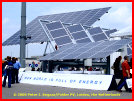 |
| <<< Portion of one of the big tracker systems of Conergy that uses huge linear single axis actuators to move several parallel arrays of PV modules by only one motor. Great attention is given to minimizing wear and tear, so that maintenance of solar parks realized with these trackers can be minimal. Single axis tracking is cheaper than double axis tracking and reduces total Balance Of System costs. Yield increase realized is claimed to be approximately 20%. | |
One
of the biggest "live" trackers was this monster from Sinosol
Technologies GmbH (former: Maxxsolar GmbH), with double axis
tracking technology and carrying 117 monocrystalline modules. The
company claims
to be able to increase the kWh output with maximum 45% as compared
to a fixed installation with a max. capacity of 21,8 kWp. For detail
of the tracking machinery, click
here. >>> |
 |
| <<< A behemoth not present in full-scale, but here in a small model, is the enormous S:Wheel® from Bavarian RW Energy GmbH (part of the Rädlinger group). Even on the biggest solar fair in the world, there was no place for a concrete and steel structure 26 meter in diameter (but only 1.8 m. high including modules) and a net weight of 7.500 kg. without modules. Up to 36 kWp can be installed onto one S:Wheel, max. 0.2 kWh/day is consumed by the tracking machinery. In Toledo (Spain) already 30 S:Wheels are running since November 2007. | |
Just another selection From the immense amount of "things to see" and an astonishing series of companies never heard of, Polder PV makes a final selection for you. Of course, only the tip of the iceberg can be shown...
|
|
Relative
novelty of Sanyo, with their remarkable
HIT module series. This powerful 230 Wp module (code: HIP-230HDE1)
has amazing almost hexagonal monocrystalline cells with rounded
corners of the "HIT-type" (instead of cutting off
4 sides from the round
ingot,
Sanyo cuts
off 6 narrower sides, resulting in cells occupying less space
in the module). Sanyo claims an astonishing, high-temperature
resistant cell type with 19.2% efficiency, for the module a respectable
16.6%. For detail of cell click
here. >>> |
 |
| <<< Integrating solar cells into, a.o., glass façades for BIPV applications demands creative solutions. Here an example of a plug-and-play "Edge Connector" to be able to position cells far from the edges from the glass laminate or module, still be able to make electrical connections and preventing laborious (and visible) electrical wiring. The connector is visible on top of this model, its prefabricated metal "feet" extend in between the glass laminate towards the contacts of the solar cell (designed for 6" cells). Cooperation project between Tyco Electronics and Solarwatt AG. Delivery of this system as of 2009. | |
Although
the Dutch PV market remains small because of ongoing political shortsightedness
and tear-jerking sabotage by bureaucrats, several companies
make good products
and sell them abroad in solar energy loving countries.
Here the busy stand of ClickFit demonstrating
their light
fixing rail system that has been TÜV certified,
although (fewer and fewer) people still do not believe what their
eyes tell
them. There is also a new, interesting flat roof frame: click
here. Thanx for the hospitality, Vincent and Theo! >>> |
 |
| <<< Green, greener, greenst. Why should a roof be an ecological wasteland of concrete, asphalt paper or rooftiles? The Deutscher Dachgärtner Verband e.V. (DDV, "German Roof Gardeners Union") thinks that even with sophisticated PV installations or solar thermal collectors, the roof should remain a living thing. There are many houses in Germany with a good match between nature and high-tech. In addition: natural water storage and insolation for free... | |
There
were several other solutions as the one mentioned under the
Clickfit section above for being able to adjust the angle of
solar panels with minimum adjusting
time.
This nice one, called Tric F, and continuously adjustable from
15
to
60 degrees, with TÜV certification,
is from Germany, Cölbe based Wagner
& Co. It can be used on flat or
slanted roofs, or in free-field arrays. >>> |
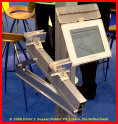 |
| <<< Very nice combination of wood and thin film solar strips by German (Neresheim, Baden-Württemberg) company Holz und Solar by Grimmeisen CEKO. Patent is pending. For German text on this system, see this pdf document. For detail photo of the façade system, click here. | |
One
of the most interesting new items on Intersolar 2008 was this Californian
invention, Solmetric's
SunEye™,
with which one can make a photograph with a fish eye lens
and directly obtain detailed
information about shadowing
of the environment on a potential location for a PV-installation.
Having a very user-friendly software interface, this will
become a wanted instrument
within the installation branche. Reviewed in German magazine Photovoltaik
07/2008: pp. 68-69. >>> |
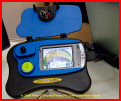 |
| <<< Professional PV-magazine Photon (the German branche) was also present at Intersolar, and... they had a very nice offer for Photon subscribers. They can use for free (as long as subscription is valid) a PHOTON-Control logger using satellite measurements to check the production of their PV-installation. A € 690 Sensorkit is optional with, a.o., a light sensor (SP Lite) made by Kipp & Zonen BV from Delft, NL (click here for detail). Subscribers seem to be in a waiting line for this fascinating offer... | |
World
PV market Number One (2% of total electricity consumption already
covered...) Bavaria, FRG, may have a lot of sun and thousands
of big PV-systems, it has also a minor extra problem: lots of
snow in winter. Deaths and severe injuries have occurred with
people trying to clean their PV-roofs of snow - a very dangerous
undertaking. This company, with the fascinating name Schneerutsch
und futsch GmbH (...), has developed an automatic snow
(and dirt: "Spray-Away") cleaning device for proud
Bavarian many-kWp PV owners wanting to stay on the safe side
and still
having some unspent money on the savings account... >>>. |
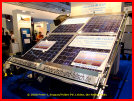 |
| <<< Public lighting is consuming large amounts of electricity. Many initiatives are undertaken for alternative lighting concepts, making use of sunlight, accu storage, and low-electricity consuming LEDs. This highly aesthetic, solar electricity-fed 24 Volt LED lamp from Zytech Solar (Zaragoza, Spain) should appeal to many community officials. Zytech is looking for distributors. For detail of the LED lamp click here. | |
SolarWorld AG sponsored beautiful racing car SolarWorld No. 1, designed by Hochschule Bochum was present live on Intersolar 2008. It is covered with multi-junction solar cells (6 m², click here for detail) that are also used in space satellites. On this front, however, the Dutch have been long-time supreme system designers with the continuing successes of the Nuna competitors sponsored by the - still Dutch - NUON utility holding. >>> |
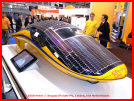 |
<<< To end this "minute" Intersolar presentation, an "outlyer" on
this PV-dominated solar fair (not mentioned the solar thermal
section, for which I did not have time...). Schott
Solar is also involved in yet another booming solar branch,
that of the Concentrating Solar (thermal) Power, CSP. German
Schott earns a lot of money producing the vacuum tubes that
are the heart of the huge parabolic trough plants built in,
e.g., U.S.A. and Spain, and soon in other sunshine-flooded
countries as well. |
|
Referenties/references
(More about Intersolar 2008 and its novelties)
Photon 6/2008 (June): pp. 99-146
Photon International 6/2008 (June): pp. 37-85
Photon
7/2008 (July): pp. 72-75
Photovoltaik 07/2008: pp. 32-44
photo
page:
http://www.intersolar.de/index.php?id=39&L=1
Polder
PV's IS 2008"special": een excursie
naar het zonnedak 30. September 2007, the Solarenergieförderverein Bayern e.V. (SEV-Bayern) celebrated their 10-year existence. This non-profit organisation was set up by - then flourishing - Siemens Solar and old public utility company Bayernwerk (later under the E.ON flag) when they realized world's first huge solar roof plant, the > 1 MWp PV-system on the curved roofs of the first halls of the Neue Messe, "München-Riem", built on the premises of the old Riem airport. This big installation was coupled to the net on November 19, 1997 while the actual installation had only begun in August of the same year. The initiators wanted the proceeds (under the then valid feed-in regime, later replaced by the EEG feed-in law) of the installation being used for the promotion of solar energy. This has been the goal of the SEV-Bayern, who has, among many other things, published several (downloadable) brochures about solar energy, organized competitions on PV architecture, BIPV, and did a lot of promotion work, for example for PV on schools since these pioneering years of large scale implementation of photovoltaic electricity in the built environment. The 1 MWp project was not the end of it, however. More halls were present or even built at the Neue Messe, and thus, more opportunities were created to extend the PV-array. This was done in a new, separate MWp project by the independent PV-project planner Phönix Sonnenstrom AG, since June 2007 known as Phoenix Solar AG. Later still, even the parking garage at the NW of the Messe complex, was covered with solar panels, forming worlds largest test array for different types of PV-modules. At Intersolar 2008, the SEV-Bayern made it possible to visit their (first-built) part of the gigantic solar roof on the Messe halls three times a day. I was lucky having let one particular dark and wet hour pass by (it was rather variable wheather during Intersolar, sun rapidly followed by strong showers), and was able to visit the roof in the sunny next shift. From the excursion balcony, restricted to a load of visitors already streched to the limit during the fair, one had some interesting views on only a fraction of the huge system (the Messe halls are not adjacent but widely spaced). You will find some photographs of the solar roof(s) on München's Neue Messe, with a few nice "shots" from space (Virtual Earth™) also including the huge PV-system on the parking garage of the premises. Bayern (Bavaria) is leading the world in realized big building-associated PV projects. München-Riem is only one of the hot-spots of solar development and well-established multi-functional use of building roofs. The photo section ends with some technical data of the systems built and reference links. I want to thank the SEV-Bayern for having made possible this unique excursion, a nice bonus on top of an already "gelungene" Intersolar 2008, for which the Fair Organisation is to be congratulated!
|
|||||||||
| <<< Looking eastward from the excursion platform in between halls B4 and B5, in the direction of the Messeturm, one already gets an impression of the extent of the huge, south-oriented PV-arrays on the slightly curved huge halls of the Messegelände (foreground: B5, B6 lying behind that hall). Details: array foreground (hall B5) and small section of array on hall B6 in the background. Note: the arrays on the "B" halls are part of the - oldest - Siemens 1 MWp system. | |||||||||
Looking
in a direction slightly north from west, onto part of the
PV-arrays on hall B4. Faintly visible, slightly to the right of the
reddish, old control tower of the former Riem airport, one can see,
on the horizon, the very thin, needle-like TV tower on the premises
of the Olympia park in the
NNE part of Munich. For detail of section left of the old control tower
(roof of hall B4), click
here. >>> |
 |
||||||||
| <<< Detail of photo shown above, hall B4, most northern part (right section of previous photo), against a backdrop of what possibly is the "Heizkraftwerk Nord" in Unterföhring (NE Münich). Hall C3, at the back, still lacking solar PV arrays. | |||||||||
Detail
of one of the DC collector cables (DC feed from 4 different arrays)
on the west side of the roof of hall B5 running to the left, where
it
is led
into
the
inside
of the
roof
towards
the
inverters via 4 separate waterproof seals. >>> |
 |
||||||||
| <<< Portion of the arrays on the west half of hall A5 (the Phönix Sonnenstrom system), looking approximately in a direction east of south. Hence, one is facing the backside of the modules, being able to see the construction of the frames. For a detail of part of these arrays showing the DC-cabling and frame construction, click here. On the right side of that photo one can clearly see that also these modules are frameless. | |||||||||
Also
on the excursion look-out an example of the module type for the first
1 MWp system is to be seen. It is a - for that time - very
powerful Siemens module having 14x6 = 84 monocrystalline cells
and a module
efficiency of 13%. It has no frame to minimize load on the roofing
structure.Therefore, broad "thin module" clamps were already used
to fix the modules on the frames. Hall A5 with part of the Phönix system
in the background. >>> |
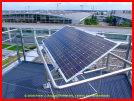 |
||||||||
Some final surprises After Google™ Earth gained momentum with their nice satellite pictures from planet Earth, Microsoft could not sit and wait, of course. They developed Virtual Earth™ instead. It has some powerful options, such as detailed photographs from some locations in a bird eye view. Luckily, Neue Messe in Munich is one of that locations. It gives an extra "dimension" on the pictures already shown on this webpage. The pictures below are from Microsoft Virtual Earth™ and were "discovered" earlier in 2008, when I was preparing for my Mega PV Radtour and the visit to Intersolar 2008 presented on this page. Only recently I found the source for the fascinating system on the parking garage:
|
|||||||||
Technical data of the solar systems on Münchens Neue Messe at the former Riem airport premises:
(1) "Solardach München-Riem" [E.ON/Siemens installation, "B" hall series]
(source: brochure "10 Jahre Engagement für Erneuerbare Energien" - SEV-Bayern e.V.)
![]() Investment
app. 7 billion Euro (app. € 6,89/Wp), 50% E.ON Energie, 20% Bavarian
Ministry of Economy, Infrastructure,
Traffic and Technology, 10% each for Siemens, Stadtwerke München (local
utility), and State Ministry
for Education and Research.
Investment
app. 7 billion Euro (app. € 6,89/Wp), 50% E.ON Energie, 20% Bavarian
Ministry of Economy, Infrastructure,
Traffic and Technology, 10% each for Siemens, Stadtwerke München (local
utility), and State Ministry
for Education and Research.
![]() Net
coupling November 19, 1997
Net
coupling November 19, 1997
![]() 1,016
MWp nominal power
1,016
MWp nominal power
![]() 7.812
frameless Siemens SM 130-L monocrystalline modules of 130 Wp each,
15% cell effiiciency, 13% module efficiency (both: STC)
7.812
frameless Siemens SM 130-L monocrystalline modules of 130 Wp each,
15% cell effiiciency, 13% module efficiency (both: STC)
![]() 84
cells/module, total 656.208 cells
84
cells/module, total 656.208 cells
![]() Total
surface of modules: 7.916 m²
Total
surface of modules: 7.916 m²
![]() Total
roof surface used for PV-system: 38.100 m²
Total
roof surface used for PV-system: 38.100 m²
![]() Orientation
South (azimuth 180º), tilt angle 28º
Orientation
South (azimuth 180º), tilt angle 28º
![]() Inverter:
3 Siemens 330 kVA inverter originally, replaced by 394 kVA inverters
during retrofit in 2007 (DC cabling
split, communication technology, inverter concept)
Inverter:
3 Siemens 330 kVA inverter originally, replaced by 394 kVA inverters
during retrofit in 2007 (DC cabling
split, communication technology, inverter concept)
![]() Net
feed-in: into the 20 kV net of Neue Messe complex
Net
feed-in: into the 20 kV net of Neue Messe complex
![]() Normalized
yield: 1.000 hours/year ("Vollaststunden", kWh/kWp.year). According to
SEV Bayern brochure average
for 1998-2006 was 979 kWh/kWp.year
Normalized
yield: 1.000 hours/year ("Vollaststunden", kWh/kWp.year). According to
SEV Bayern brochure average
for 1998-2006 was 979 kWh/kWp.year
![]() Performance
ratio: best in 2004, 80,6%
Performance
ratio: best in 2004, 80,6%
![]() Yield:
app. 1 billion kWh (1 GWh)/year, that is app. 4% of total consumption
of the Messe complex. Table in SEV Bayern's
brochure gives average of 994 MWh/year for 1998-2006)
Yield:
app. 1 billion kWh (1 GWh)/year, that is app. 4% of total consumption
of the Messe complex. Table in SEV Bayern's
brochure gives average of 994 MWh/year for 1998-2006)
![]() CO2
production eliminated: app. 650 ton/year
CO2
production eliminated: app. 650 ton/year
![]() Fixed
feed-in tariff as of enhancement by EEG: € 0,506/kWh
Fixed
feed-in tariff as of enhancement by EEG: € 0,506/kWh
![]() Proceeds
from feed-in used via SEV-Bayern for the promotion of solar energy
Proceeds
from feed-in used via SEV-Bayern for the promotion of solar energy
![]() Much
more and actualized info on SEV-Bayern website:
http://www.sev-bayern.de/index.php?entryid=14
Much
more and actualized info on SEV-Bayern website:
http://www.sev-bayern.de/index.php?entryid=14
(source: website Phoenix Solar and linked pdf file)
![]() Investment
app. 5,5 billion Euro (app. € 5,20/Wp), Phoenix Energy Investments,
financed as 6 separate so-called Bürgerbeteiligungsanlagen (financing
projects by citizens, presumably 1 hall roof each) via Phoenix Solar
FondsVerwaltung
GmbH & Co.KG. Former partners of the
first "Siemens" installation, as well as Shell Solar GmbH and the
Messe München were
also involved in this second
megaproject.
Investment
app. 5,5 billion Euro (app. € 5,20/Wp), Phoenix Energy Investments,
financed as 6 separate so-called Bürgerbeteiligungsanlagen (financing
projects by citizens, presumably 1 hall roof each) via Phoenix Solar
FondsVerwaltung
GmbH & Co.KG. Former partners of the
first "Siemens" installation, as well as Shell Solar GmbH and the
Messe München were
also involved in this second
megaproject.
![]() Net
coupling/installation 2002. Record breaking installation time in 6
weeks...
Net
coupling/installation 2002. Record breaking installation time in 6
weeks...
![]() 1,058
MWp nominal power
1,058
MWp nominal power
![]() 7.560
frameless Siemens Sp 140 (PowerMax®) monocrystalline modules of
140 Wp each, possibly Shell Solar?
7.560
frameless Siemens Sp 140 (PowerMax®) monocrystalline modules of
140 Wp each, possibly Shell Solar?
![]() 72
cells/module, total 544.320 cells
72
cells/module, total 544.320 cells
![]() Total
surface of modules: 9.966 m²
Total
surface of modules: 9.966 m²
![]() Orientation
South (azimuth 180º), tilt angle 22º
Orientation
South (azimuth 180º), tilt angle 22º
![]() Kalzip fixation system to ribbed metal roof (now part of Corus)
Kalzip fixation system to ribbed metal roof (now part of Corus)
![]() Inverter:
5 Siemens Sinvert 200 kVA
Inverter:
5 Siemens Sinvert 200 kVA
![]() Net
feed-in: presumably also into the 20 kV net of Neue Messe complex
Net
feed-in: presumably also into the 20 kV net of Neue Messe complex
![]() Normalized
yield: 965 kWh/kWp.year
Normalized
yield: 965 kWh/kWp.year
![]() Yield:
1.021.000 kWh/year (according to Phoenix 10% above the expected yield)
Yield:
1.021.000 kWh/year (according to Phoenix 10% above the expected yield)
![]() CO2
production eliminated: 986 ton/year [BMU AGEE]
CO2
production eliminated: 986 ton/year [BMU AGEE]
![]() Fixed
feed-in tariff as of 2002: € 0,481/kWh, 20 years long
Fixed
feed-in tariff as of 2002: € 0,481/kWh, 20 years long
![]() Resulting
annual financial yield: app. € 477.000/year
Resulting
annual financial yield: app. € 477.000/year
(3) "Park Deck Messe München - PV Enlargement test PV-plant/Solarstrom Testfeld" on Parkhaus West flat roof (530 m. above sea-level)
This plant is part of the EU-subsidized "PV Enlargement" project in 10 European countries, in which a grand total of 1,218 kWp of "highly cost-effective or very innovative PV technologies" is demonstrated "for increasing public awareness about and visibility of PV solar electricity", as is stated on the homepage of this project. Which is financed via the 5th framework programme of the European Commission, DG-TREN. It claims to be the worlds largest test field for PV module technology comparison.
(sources: Messe München website and pages on website of PV Enlargement project)
![]() 655
kWp nominal power in total according to Messe München site (398,7
kWp is mentioned on the PV Enlargement site, but the specific page
linked below is
dated 04.05.2007.
It is possible that then only part of the actual system was installed)
655
kWp nominal power in total according to Messe München site (398,7
kWp is mentioned on the PV Enlargement site, but the specific page
linked below is
dated 04.05.2007.
It is possible that then only part of the actual system was installed)
![]() Orientation:
south, tilt 27 degrees
Orientation:
south, tilt 27 degrees
![]() Net
coupled in 2003-2004 (thin film), last crystalline technology followed
in 2005
Net
coupled in 2003-2004 (thin film), last crystalline technology followed
in 2005
![]() Nominal
module power between 55 and 220 Wp
Nominal
module power between 55 and 220 Wp
![]() Many
different module types with comparison between large scale thin-film
technologies (2x CIS; 1x aSi; 1x CdT; 1x
HIT) with crystalline technology (mono- and polycrystalline Si). 11
different PV-technologies are included, the smallest
array having a nominal (total) power of 9 kWp, the largest 61 kWp
Many
different module types with comparison between large scale thin-film
technologies (2x CIS; 1x aSi; 1x CdT; 1x
HIT) with crystalline technology (mono- and polycrystalline Si). 11
different PV-technologies are included, the smallest
array having a nominal (total) power of 9 kWp, the largest 61 kWp
![]() Also:
large-scale comparison of 5 different inverter technologies
Also:
large-scale comparison of 5 different inverter technologies
![]() Taking
into account the reported "grand" total of 21.900 modules
on the Messe München site, this test system should
consist of 21.900 - 7.812 (Siemens
system) - 7.560 (Phönix system) = 6.528 modules
Taking
into account the reported "grand" total of 21.900 modules
on the Messe München site, this test system should
consist of 21.900 - 7.812 (Siemens
system) - 7.560 (Phönix system) = 6.528 modules
![]() Total
surface of roof available on Neue Messe: 149.000 m², total surface
(incl. Parkhaus) used for PV: 75.000 m²
Total
surface of roof available on Neue Messe: 149.000 m², total surface
(incl. Parkhaus) used for PV: 75.000 m²
More information about this very interesting test plant:
http://p12892.typo3server.info/64.0.html (with
photo's and detailed information about the module types involved)
http://p12892.typo3server.info/uploads/media/PVSEC21-WIP.pdf (scientific
report with results of comparison, presented september 2006 at PVSEC21)
Further info of Messe roof PV-systems:
http://tuprints.ulb.tu-darmstadt.de/290/12/Anhang_B11_B13.pdf (extensive
technical description and analysis of 1st Siemens MWp system)
http://www.messe-muenchen.de/de/Home/cn/Presse/26092/26094/26511 (press
release Messe München after installation 2nd Phönix MWp system)
© August 9, 2008 Peter J. Segaar/Polder PV, Leiden, the Netherlands
|